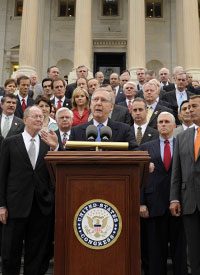
The Republican budget calls for $500 billion-plus annual deficits through 2019. Every annual deficit in the Republican budget would be larger than any deficit in the entire history of the nation before 2008. The only thing that would give these huge deficits the appearance of being "conservative" is that the deficits in the Obama budget would end up being even bigger.
The website for the House Republicans calls their plan “Fiscal Responsibility: Republicans on the Budget,” and admittedly it would cut the Obama deficit by about $100 billion per year. But since when is calling for $500 billion-plus annual deficits forever “fiscal responsibility”?
That $500 billion figure is actually dishonestly optimistic in that doesn’t count an average of $130 billion stolen from “trust funds” annually. So the actual deficit would be in the $600-700 billion per year range if the stolen trust funds were included.
Moreover, the Republican budget plan, unlike the Obama budget, does not contain any economic assumptions. Is the GOP plan based on the Obama administration’s Pollyannaish economic assumptions? The Republican plan doesn’t say, so the deficits under this plan could be far more larger than projected.
The Republican plan would increase the size of the federal government by nearly four percent per year: "Total mandatory spending [about three-fourths of total federal spending] increases by an average of 3.9 percent per year for the next 10 years. This is slightly slower growth than projected in the Congressional Budget Office baseline and the Obama/Democratic budget.”
If the best that the Republican Party can do is claim — using their own words — “slightly slower growth” than Obama’s spending proposals, what’s to be said of Republican “principles”? The Republican leadership seems to have confused the word “principles” with “percentages.”
Republicans clearly are a party of big government. They want all the government the Obama administration would bring to America, except that they would bring this about at a slower rate.
Massachusetts State Senator Robert Hedlund once told a community newspaper in his south-of-Boston district: “When the voters are given a choice between a Democrat and a Republican who presents himself as a cheap imitation, they will usually go for the real thing.” As someone who has been continuously re-elected in one of nation’s strongest Democratic bastions, this Republican Liberty Caucus member has witnessed the continuous suicide of the Massachusetts Republican Party firsthand for two decades. The national Republican Party is clearly taking the suicidal path of the liberal Massachusetts Republican Party, which is so small that it could practically hold a legislative caucus in a phone booth.
Congressman Paul Ryan (Wis.), the ranking Republican on the House Budget Committee, was effusive about the GOP budget alternative: on his budget: “Republicans must not only act to stop this disastrous course, but offer the American people a better choice. Our budget alternative provides a path out of our current crisis – by restoring economic growth and job creation, controlling spending and deficits — and by lifting the crushing burden of debt and taxes from future generations.” How so? Though the Republican budget fails to provide total national debt figures (let the reader guess why), it does mention that the portion that’s held by the “public” would nearly double from $8.5 trillion this year to nearly $13.7 trillion in 2019.
So how is that “lifting the crushing burden of debt and taxes from future generations”? It isn’t, if you understand the English language. There’s only one word fit for this kind of statement: lying.
The Republican budget does represent one significant change, however. It represents the ultimate victory of supply-side economics over the party in Congress. Supply side economics is the inbred, saw-toothed cousin of Keynesian economics, and it served as the operating philosophy under the Bush administration. It’s the reason for the current economic mess.
Somebody should have told the House Republicans that supply-side economists were universally wrong in predicting the current crisis. Steve Forbes and supply side godfather George Gilder had no inkling that a serious recession was coming. And Arthur Laffer, author of the famous supply-side “Laffer curve” said the economy was on solid ground.
Supply-side economics teaches its adherents that deficits don’t matter and that if government keep cutting taxes and increasing spending that the budget will eventually balance itself.
Naturally, the Republican budget includes a “tax cut” in the form of an income tax rate reduction. And a tax cut is good if it’s paired with spending cuts. But it isn’t there. The phrases “spending cut” and “program cut” appear nowhere in the Republican budget. The Republican budget outlines no program cuts. Not one.
The budget fails to highlight (again, let the reader guess why) how the increases in spending would be paid. The income tax cut is chimerical. All the Republicans would do is transfer the tax from incomes to an inflation tax that would result from printing more money to finance the deficit spending. Instead of paying more on April 15, Americans will simply pay more at the grocery store and the gasoline pump, or their children will be shouldered with crushing debt. More than likely under a Republican budget, it would be both.
The GOP budget is rife with relative spending data. There’s little real data in it, and that’s consistent with supply-side ideology (or perhaps “mythology” would be a more appropriate word). Supply-side economics teaches that growth can fund increases in the size of government without raising taxes. Therefore, the only important factor is keeping government within acceptable proportions of Gross Domestic Product. Thus, the Republicans have filled their budget with relative “percentage of GDP” data that tells the American people nothing about the real spending levels. After all, how could they figure out how much was being spent if the GOP didn’t provide economic growth numbers? And they didn’t. Let the reader figure out why the Republicans didn’t list their economic assumptions.
Americans now have a choice between two parties of big government, though the recent Republican budget reveals that the Republicans are the less honest of the two big government parties — less honest because they cut taxes without cutting spending and rely even more heavily on the inflation tax.
Photo of Republicans announcing their alternative budget plan: AP Images



